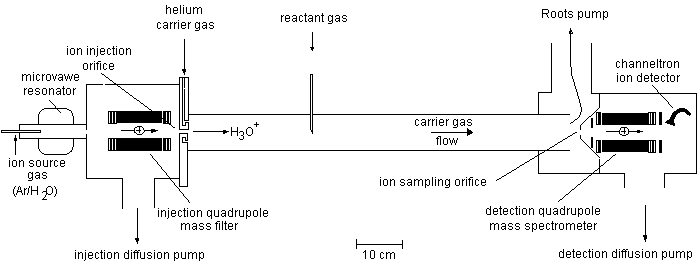SIFT - Selected Ion Flow Tube
Ion-molecule reactions
The selected ion flow tube, SIFT, technique is a fast flow tube / ion swarm method for the study of the reactions of ions (positive or negative) with atoms and molecules under truly thermalised conditions over a wide range of temperature. It has been extensively used to study ionmolecule kinetics. Its application to atmospheric and interstellar ion chemistry by several eminent groups over a 20-year period has been crucial to the advancement and understanding of these interesting topics.
The resulting data are included in the the recent compilation by Anicich VG. 2003. An Index of the Literature for Bimolecular Gas Phase Cation-Molecule Reaction Kinetics, JPL Publication 03-19. Pasadena: NASA
http://trs-new.jpl.nasa.gov/dspace/bitstream/2014/7981/1/03-2964.pdf
Recently it has been developed as a very sensitive chemical ionisation analytical technique for the detection and quantification of trace gases in air and in human breath down to the ppb level and in real time.
The SIFT apparatus
In the SIFT apparatus the ions are created in an ion source which is external to the flow tube. The ions are then extracted from the ion source, selected according to their mass-to-charge ratio using a quadrupole mass filter (see Figure 1) and injected into a flowing carrier gas (usually helium at a pressure of 0.5 Torr) via a small orifice ( ~1 mm diameter).

Figure. 1. The SIFT instrument.
The carrier gas is inhibited from entering the quadrupole mass filter chamber by injecting it into the flow tube through a Venturi-type inlet at near-supersonic velocity in a direction away from the orifice (see Figure 1). In this way a swarm of a single ion species thermalised at the same temperature as the carrier gas are convected along the flow tube ( ~1 m long), sampled by a downstream pinhole orifice, mass analysed and counted by a differentially-pumped quadrupole mass spectrometer system.
To study a particular ion-molecule reaction, a reactant gas is introduced at a measured flow rate into the carrier gas. Then by measuring the count rates, n1, of the reactant and product ions using the downstream mass spectrometer and relating them to the number density of the reactant gas, n3, in the carrier gas, the k for the reaction and the ion products can readily be determined .

The rate coefficients and ion products of the reactions of practically any positive or negative ion species with many gases can be studied using the SIFT, provided that the ions can be extracted from the ion source at a sufficient current (~10-9 A is the practical lower limit) and that they can be injected at a sufficiently low energy to avoid their fragmentation in collisions with the carrier gas. Even weakly-bound species such as H3O+(H2O)3 ions have been injected without undue dissociation. Low-pressure and high-pressure electron impact sources and even flowing afterglow sourcesare routinely used to prepare a wide variety of positive and negative ions. For the use of the SIFT for SIFT-MS trace gas analysis, a microwave discharge source is used (see below).
Typical reactions of the H3O+, NO+ a O2+ with organic molecules
| ion specie |
H3O+ |
NO+ |
O2+ |
| proton transfer |
+ |
|
|
| hydride ion (H-) and hydroxid ion(OH-)transfer |
|
+ |
|
| ternary association |
|
+ |
|
| charge transfer and dissociative charge transfer |
|
+ |
+ |
| 